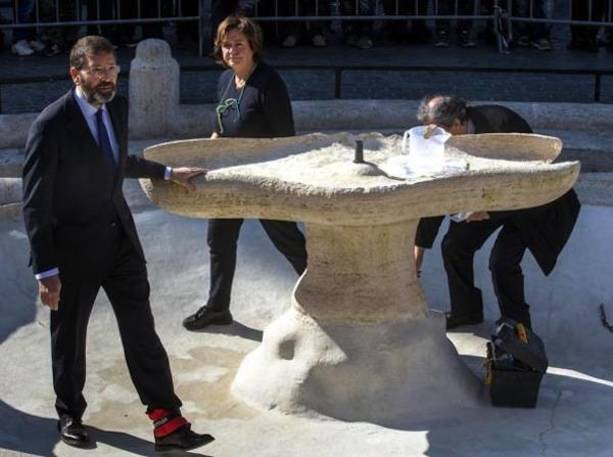


ROME – The day after it was damaged by drunken Dutch soccer hooligans Feb. 19 I paid a visit to the Bernini fountain called La Barcaccia – the big boat. Already the entire fountain was, like the surrounding Piazza di Spagna itself, spotlessly clean.
As a silent, meditative crowd stood behind the new barriers surrounding the fountain, restorers took photographs documenting the 110 signs of damage blamed upon the Dutch Feyenoord fans. In Rome for an Europa League match against AS Roma, some of them urinated into wine bottles which they then threw at police.
To hear of this, and, worse still, to see the damage is certainly shocking, and cost estimates for at least an attempt at restoration begin at $3.3 million. A series of visibly deep chips mar the rim of the boat, which is sculpted of travertine. On the positive side, not everyone agrees that the damage is “irreparable and permanent,” as Giovanna Marinelli, head of culture for city hall, has declared.
The often cantankerous (and brilliant) art historian Vittorio Sgarbi maintains that the fountain can surely be repaired. For Sgarbi, some of the damage to the travertine may well be due to its recent restoration, completed only last year. “The damage is virtually nonexistent,” he said in an interview with the daily Il Messaggero. The previous cleaning of the travertine had made it particularly fragile, Sgarbi went on to say. “The real damage, for me, is the lack of respect – turning the fountain into a garbage dump.”
Sgarbi had no sooner spoken than Florentines were complaining about the rash of graffiti writers sullying their city. From Florence Aldo Luigi wrote that, “We were all so scandalized at the Dutch who made Rome filthy, but at least they don’t do that in their own homes, while we put up with the Italian cretins who vandalize their own and our house. At least the Dutch who were arrested will have to pay Euro 45,000, but when ours get stopped by the police all they get is a lecture and then let go home.” (For a video of Florentine graffiti, see <<< [2] ).
Rome itself is hardly immune: the walls of the entire area surrounding Campo de’ Fiori and Trastevere are disgustingly filled with graffiti, as are even new commuter trains, both inside and out, to the point that it can be hard to see out a window. So far it has been useless to point out that, if all are removed immediately, the writers tend to stop, as has been shown in other cities. In addition, some here still praise the writers as artists. Some may be, but not in the great historic cities of Italy. (To see Roman graffiti, check out <<< [3]).
What is to be done to avoid such problems in the future? Already in Rome there are fears of a potential clash next Saturday, when Northern League leader Matteo Salvini will hold a political rally at Piazza del Popolo. Anti-Salvini posters are scattered around town, with an invitation for a march against his version of the Northern League expanding into the Center and South. Police here will try to keep the two demonstrations at a distance, but that will not be easy. Gleeful tourists regularly jump into other beloved historical fountains, like the Trevi Fountain, newly restored for the second time in twenty years. Worse still – far worse, obviously – are the threats from the Jihadist militants that they will come to Rome.
For the moment, no one quite knows how best to protect the fragile Italian cities like Venice as well as Rome and Florence from hooligans, tourists, graffiti and the Italians themselves. One suggestion is to put more monuments behind iron fencing, as was done in the turbulent Eighties and Nineties, when political clashes were frequent. In this way the Column of Marcus Aurelius and the Arch of Constantine in Rome were protected from vandalism.
Antonio Paolucci, director of the Vatican Museums, rules out this solution. When he was superintendent of culture (museums, sites) in Florence, a fence was proposed to protect the 14th century Loggia dei Lanzi, which had become a haven for homeless, who slept there and had damaged it. He vetoed this in favor of “continuous police vigilance, the best way albeit very costly.”
Marinelli agrees, urging better police work and an increase in surveillance cameras. Perhaps most sensibly she also points out that Romans are so accustomed to being surrounded by beauty and historic sites that they become immune to them. “We are considering activating teaching in the schools so that future generations who will be the custodians of our cultural heritage will appreciate it more,” she says.
In the meantime a Dutch woman living in Rome, Elisabeth Jane Bertrand, has launched an appeal for funds to help with the Barcaccia restoration, and in two days collected, via her website Scusa roma Actie, Euro 4,000.
Source URL: http://test.casaitaliananyu.org/magazine/focus/facts-stories/article/after-barcaccia-what-be-done
Links
[1] http://test.casaitaliananyu.org/files/roma1424724927jpg
[2] http://video.corrierefiorentino.corriere.it/nella-citta-devastata-graffiti/7f6b5e12-bb3a-11e4-bee3-9a5502b82b9d
[3] https://www.youtube.com/watch?v=U1Yxm02lUz0